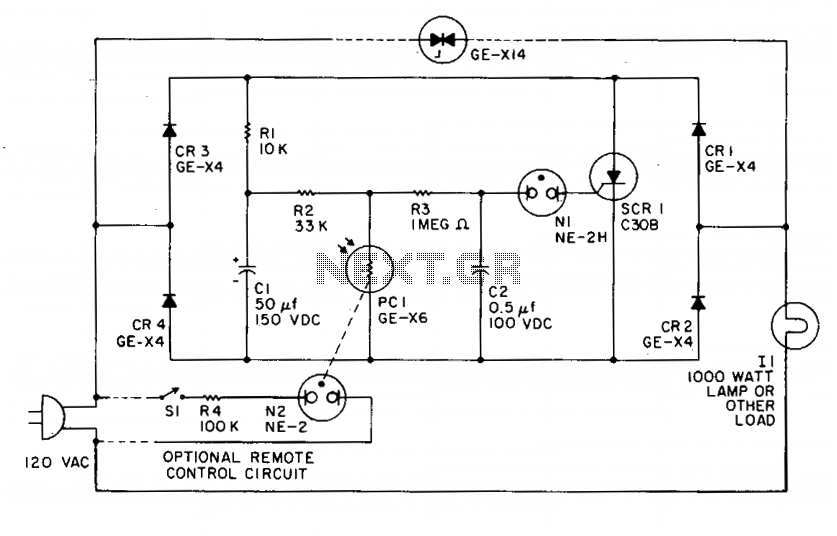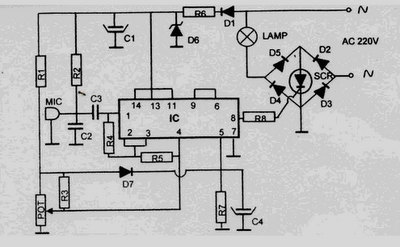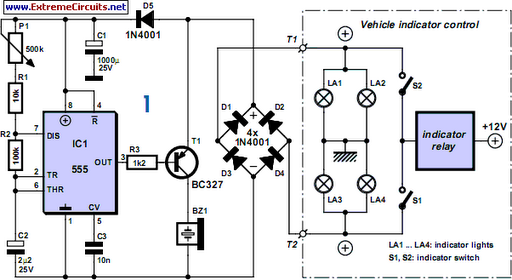
1 A LAMP FLASHER

The National LM195 power transistor is activated and deactivated once per second to flash a 12-V lamp. The current limiting feature of the LM195 prevents high peak currents during turn-on, even when a cold lamp can draw up to eight times the normal operating current. This current-limiting capability extends the lamp's lifespan in flashing applications.
The LM195 power transistor serves as a reliable component in circuits designed for flashing lamps, particularly in applications where the lamp experiences significant inrush current upon activation. The transistor is designed to handle the demands of switching at a frequency of one second, making it suitable for visual signaling or decorative lighting.
In the context of a typical circuit using the LM195, the transistor is configured in a common emitter arrangement. When the circuit is powered, the LM195 is triggered by a timing circuit, often utilizing a resistor-capacitor (RC) network to create the desired flashing frequency. The timing circuit charges the capacitor until the threshold voltage is reached, turning on the LM195 and allowing current to flow through the lamp.
The current-limiting feature is critical in this application. It is designed to sense the current flowing through the lamp and limit it to a safe level, thereby preventing damage from excessive current draw. This is particularly important during the initial turn-on phase when the lamp may draw a much higher current due to its cold state. By limiting this peak current, the LM195 not only protects the lamp but also enhances its operational lifespan, making it ideal for applications where the lamp is frequently cycled on and off.
Thermal protection is another noteworthy aspect of the LM195. The device incorporates thermal shutdown features that prevent overheating, thereby ensuring reliable operation over extended periods. This is particularly beneficial in environments where the lamp may be subjected to varying ambient temperatures or where heat dissipation is a concern.
Overall, the LM195 power transistor provides an efficient and reliable solution for controlling the operation of 12-V lamps in flashing applications, combining current limiting and thermal protection to enhance performance and longevity.National LM195 power transistor is turned on and off once per second for flashing 12-V lamp. Current limiting in LM195 prevents high peak currents during turnon even though cold lamp can draw 8 times normal operating current. Current-limiting feature prolongs lamp life in flashing applications. -R. Dobkin, "Fast IC Power Transistor with Thermal Prot ection, " National Semiconductor, Santa Clara, CA, 1974, AN-110, p 5. 🔗 External reference
The LM195 power transistor serves as a reliable component in circuits designed for flashing lamps, particularly in applications where the lamp experiences significant inrush current upon activation. The transistor is designed to handle the demands of switching at a frequency of one second, making it suitable for visual signaling or decorative lighting.
In the context of a typical circuit using the LM195, the transistor is configured in a common emitter arrangement. When the circuit is powered, the LM195 is triggered by a timing circuit, often utilizing a resistor-capacitor (RC) network to create the desired flashing frequency. The timing circuit charges the capacitor until the threshold voltage is reached, turning on the LM195 and allowing current to flow through the lamp.
The current-limiting feature is critical in this application. It is designed to sense the current flowing through the lamp and limit it to a safe level, thereby preventing damage from excessive current draw. This is particularly important during the initial turn-on phase when the lamp may draw a much higher current due to its cold state. By limiting this peak current, the LM195 not only protects the lamp but also enhances its operational lifespan, making it ideal for applications where the lamp is frequently cycled on and off.
Thermal protection is another noteworthy aspect of the LM195. The device incorporates thermal shutdown features that prevent overheating, thereby ensuring reliable operation over extended periods. This is particularly beneficial in environments where the lamp may be subjected to varying ambient temperatures or where heat dissipation is a concern.
Overall, the LM195 power transistor provides an efficient and reliable solution for controlling the operation of 12-V lamps in flashing applications, combining current limiting and thermal protection to enhance performance and longevity.National LM195 power transistor is turned on and off once per second for flashing 12-V lamp. Current limiting in LM195 prevents high peak currents during turnon even though cold lamp can draw 8 times normal operating current. Current-limiting feature prolongs lamp life in flashing applications. -R. Dobkin, "Fast IC Power Transistor with Thermal Prot ection, " National Semiconductor, Santa Clara, CA, 1974, AN-110, p 5. 🔗 External reference





